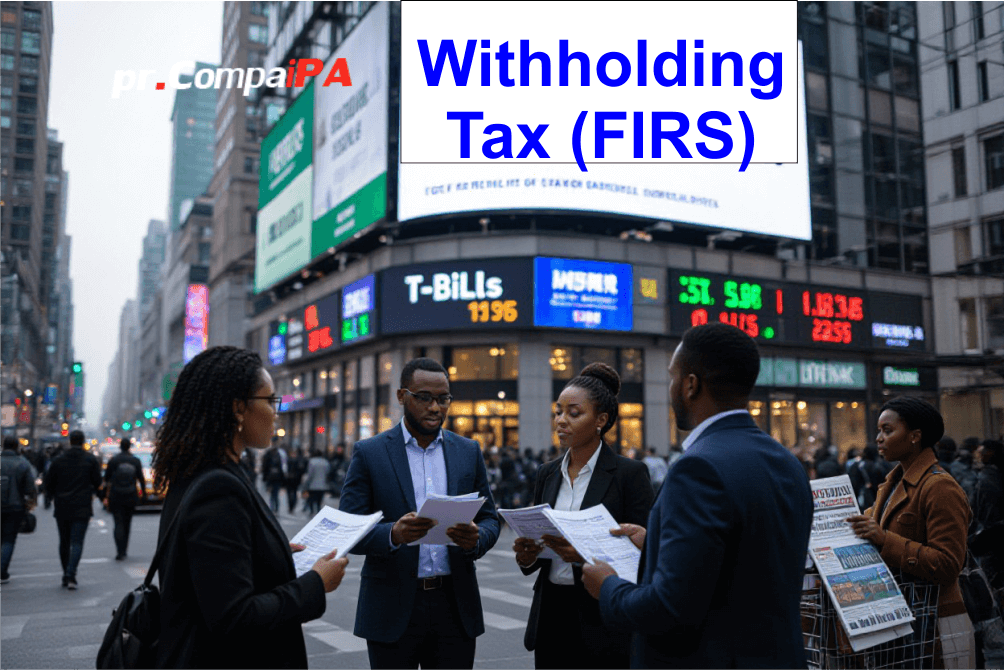Withholding Tax Enforcement Begins on Short-Term Securities; FGN Bonds Exempt
Most times, you just want to park your money in T-Bills, CPs, or short-term notes and not worry about the fine print – but this new 10% withholding tax from FIRS means your actual take-home yield is changing, whether you like it or not. If you buy T-Bills, corporate bonds, commercial papers, or notes, your interest is now getting clipped at source, while FGN bonds stay completely exempt, which quietly tilts the playing field in its favor.
Key Takeaways:
- For anyone parking cash in short-term instruments, this new 10% withholding tax on interest basically means your actual take-home yield just dropped a bit, so you need to re-check all those “safe” return assumptions.
- The tax hits interest from T-Bills, corporate bonds, commercial papers, and notes that run for one year or less, so a lot of treasury and cash-management products that used to feel tax-light are now directly in the firing line.
- FGN bonds staying exempt creates a clear tilt in favor of longer-term government debt, which might quietly nudge both retail and institutional investors to stretch their duration if they want to avoid the extra tax drag.
- Short-term corporate funding is going to feel this because issuers may have to offer higher rates to keep investors interested after tax, which can bump up overall borrowing costs in the market.
- Yield quotes suddenly matter a lot more – you’ve got to pay attention to whether rates are shown gross or net of the new withholding, otherwise portfolio projections, ALM models, and even simple cash forecasts can end up way off.
- Tax planning for treasurers and high-net-worth investors just got more nuanced, since laddering into a mix of T-Bills, CPs, and FGN bonds might be the only way to balance liquidity needs with the new tax hit.
- Because FIRS is explicitly backing this with clear rules, compliance risk jumps if you ignore it, so custodians, brokers, and portfolio managers need to quickly tighten processes around deduction, remittance, and client reporting.

So, What’s This Withholding Tax All About?
It’s Not A New Tax, It’s A New Target
A lot of people think this 10% thing is some brand-new tax the government just cooked up overnight, but that’s not really what’s going on here. Withholding tax has been in your life for years – on rent, contracts, dividends – what FIRS has done now is drag short-term securities into that same net. So every time you earn interest on T-Bills, commercial papers, corporate bonds under 10 years, or those short-term notes, 10% of that interest is chopped off at source as withholding tax, before the cash even hits your account.
In practical terms, if you buy a 182-day T-Bill that should pay you interest of ₦1,000,000 at maturity, you don’t just walk away with the full ₦1,000,000 anymore. The paying agent (usually your bank or broker) will withhold ₦100,000 as tax and credit you ₦900,000 instead. That 10% is not on your principal, it’s strictly on the interest component, so if you invested ₦10,000,000 and your maturity value is ₦11,000,000, the tax applies only on the ₦1,000,000 gain, not the full ₦11,000,000.
How It Actually Works For You Day To Day
What trips most investors up is the fact that this is a final tax for some people, but not for everyone. If you’re an individual earning interest on these short-term instruments, that 10% is typically treated as final on that income, so you don’t go and pay another round of income tax on the same interest. But if you’re a company, that withheld amount often just becomes a credit against your final income tax, so you still need to report the income and reconcile it in your tax computations.
Take a simple example: your company earns ₦20,000,000 interest on a series of commercial papers over the year, and ₦2,000,000 has already been withheld and remitted to FIRS. When your accountants are doing your company income tax return at 30% on total profits, that ₦20,000,000 interest is still part of your taxable profit base, but the ₦2,000,000 shows up as tax already paid, reducing how much extra you eventually send to FIRS. If you’re a retail investor, on the other hand, it’s more straightforward – 10% is taken out, you pocket the rest, and your main headache is simply that your effective yield just dropped compared to what you were used to before this rule kicked in.
Who’s actually collecting it and how?
From your side, you’re not writing any separate cheque to FIRS – the tax is grabbed before the interest hits your account. The paying entity (for T-Bills, that’s usually the DMO via your bank or broker, for CPs and corporate bonds, it’s the issuer or paying agent) withholds 10% of the interest and remits it to FIRS, then credits you with the balance. If your gross interest on a CP position is 10 million naira, what finally lands with you is 9 million, with 1 million quietly heading to the taxman.
Because it’s a withholding tax, it’s typically treated as a final tax on that interest for individuals, but your own situation can get a bit more nuanced if you’re operating through a company or fund structure and doing proper tax computations at year’s end. You’ll also start seeing this reflected more explicitly in term sheets, deal notes, and contract notes from your bank or broker – smart thing is to check whether quoted yields are gross or net of the 10% WHT, so you’re not shocked later when the numbers don’t match what you pencilled into your spreadsheet.
What Kinds of Securities Are Affected?
Short-Term Government and Corporate Instruments
Ever wondered which of your fixed-income picks are now getting hit with that 10% deduction right off the top? The short answer is: anything short-term that pays you interest and isn’t a qualifying FGN bond is now in the firing line. So if you’re buying 91-day or 182-day Treasury Bills at auction or in the secondary market, the discount you earn at maturity is now subject to 10% withholding tax, regardless of whether you’re a bank treasury desk, a fund manager, or just a retail investor using your mobile app.
Same story with short-term corporate paper – commercial papers (CPs), corporate notes, bank-issued notes, structured short-term notes, you name it. If it’s a debt instrument with a maturity of 1 year or less and you’re earning interest or discount income, FIRS wants 10% withheld at source. A 180-day CP paying you 15% annualized? Your effective net yield now drops, because 10% of that interest portion is taken out as WHT before you even see the cash.
What’s In, What’s Out, And The Gray Areas
On the flip side, your qualifying Federal Government of Nigeria bonds still sit in a different bucket. Those multi-year FGN bonds – say a 5-year or 10-year paper – continue to enjoy their long-standing tax-exempt status on interest, so the WHT rules don’t touch them. That means if you’re shifting part of your portfolio from 182-day T-Bills into 7-year FGN bonds, you might actually be trading some liquidity for cleaner, tax-free coupons.
Where it gets interesting for you is around hybrid or structured products that wrap short-term notes, repos, or money market instruments. If the underlying instrument is a short-term security paying interest, expect withholding to apply, even if your broker or asset manager is selling it to you as part of a “liquidity fund” or “cash management” product. So your T-Bills, bank-issued CPs, short-term corporate notes, and similar fixed-income instruments are in the tax net, while long-tenor FGN bonds, and in some cases specific exempt supranational or state-backed issues, sit outside – and that simple line can totally change how you think about yield.
T-Bills – What You Need to Know
With T-Bills regularly auctioned at 3-month, 6-month, and 1-year tenors, they sit squarely in the crosshairs of this 10% withholding tax. You’re dealing with discount instruments here, so the tax doesn’t hit your principal; it bites into the discount income – that difference between what you pay and the face value you receive at maturity. If you buy a 1-year T-Bill at a 17% implied yield, your effective take-home isn’t 17% anymore; it’s closer to 15.3% after withholding.
What trips a lot of people up is that T-Bills are often rolled like a conveyor belt: you cash out one maturity and immediately buy another, and for years, you never thought about tax planning around that cycle. Now your broker or bank will deduct 10% withholding at the point the income crystallises – that is, at maturity or on sale if you offload in the secondary market. So if you’re a treasury-heavy investor or managing a cash-heavy business, you really need to start running your cash models on net yields, not the glossy CBN auction numbers.
Corporate Bonds – The Fine Print
Most corporate bonds in Nigeria are issued in the 3 to 7 year range, which means a big chunk of them fall right into the “10 years or less” bucket that FIRS is targeting. You’re typically earning coupon interest semi-annually, and that’s exactly what the 10% withholding tax will latch onto, regardless of whether it’s a tier-1 bank bond, a manufacturing company issue, or an infrastructure SPV with a fancy name. If the tenor at issuance is 10 years or less, your coupons are now subject to the chop.
In practical terms, if you’re holding a 5-year corporate bond paying 18% per annum, your headline coupon of 18% shrinks to an effective 16.2% once 10% withholding is deducted on each coupon payment. That gap matters a lot when you’re comparing it against a similar tenor FGN bond that remains fully exempt, especially for institutions running tight spread-based strategies. So when your relationship manager shows you a “high-yield” corporate issue, your first question should be: “What’s the post-tax yield versus an equivalent FGN?”
Another subtle detail you can’t ignore is how this affects pricing in the secondary market. As investors internalise the 10% drag on coupons, they’re likely to demand higher pre-tax yields on new issues, which can push down prices on existing bonds that are already locked into lower coupons. If you’re already holding a portfolio of sub-10-year corporates, you’re not only taking a hit on the income side, you might also see some mark-to-market impact as the market reprices to account for tax, especially for thinly traded names where even small shifts in sentiment move the needle.
CPs and Notes – Are You Covered?
Commercial papers in Nigeria typically run from 30 days up to about 270 days, and that entire spectrum is now unambiguously inside the 10% withholding tax net. You’re usually buying CP at a discount, just like T-Bills, and expecting a clean lump-sum payout at maturity, but that lump sum will now be clipped by 10% on the income portion. So if your company is parking 500 million naira in a 180-day CP at 19%, your effective annualised return suddenly isn’t 19% when the taxman has taken his cut.
Short-term notes, including bank-issued notes and structured investment notes marketed to HNIs, also get pulled in so long as the stated tenor is 10 years or less, which for most of these products is often 1 to 5 years. And because a lot of these notes are sold with shiny brochures and “enhanced yield” features, it’s very easy to overlook the simple question: is the interest subject to withholding tax under the new rule, or is there a genuine exemption backed by law? If you can’t see the tax treatment clearly spelled out in the term sheet, you should assume 10% WHT is coming off your interest and price the deal on that basis.
One more wrinkle you should keep in mind with CPs and notes is how the tax interacts with liquidity and rollover strategies. Many treasurers like to run rolling CP programs or cycle through 90-day notes to fine-tune cash flows, but once you plug in 10% withholding on each maturity event, the compounding effect of that drag over a full year becomes very real. It might push you to lengthen tenor slightly into tax-free FGN territory, or to be far more selective about issuers and structures that justify a post-tax yield premium, rather than chasing every shiny short-term paper that crosses your desk.

Why FGN Bonds Get a Pass
The Policy Logic Behind The Exemption
Most people assume FGN bonds are exempt just because they’re “government stuff,” and that’s where the story ends, but there’s a bit more meat on that bone. You’re basically looking at an instrument the Federal Government uses to fund long-term infrastructure, plug budget gaps, and manage debt sustainability, so policymakers are very careful about anything that could spook demand. If you slap a 10% withholding tax on coupon payments for a 5, 10, or 20-year FGN bond, you instantly make it less attractive relative to competing assets, especially for pension funds and foreign portfolio investors that live and die by post-tax yield.
You also have to see it in the context of Nigeria’s broader tax and debt strategy: the government is trying to lengthen the maturity profile of its debt and shift away from super-expensive short-term borrowing. By keeping long-term FGN bonds tax-exempt while taxing T-Bills and other short-term paper, policy quietly nudges you (and big institutional players) toward the longer end of the curve. In other words, the tax rule is doing double duty – raising revenue on short-term flows while still protecting the government’s flagship funding instruments from a hit to demand.
What This Means For Your Portfolio
From a practical angle, you now get a pretty clear hierarchy when you map out your fixed income options: interest from your T-Bills, corporate bonds with short residual tenor, CPs, and notes take a 10% haircut at source, but the coupon from your FGN bonds comes in clean. So if you’re building a conservative portfolio and you’re torn between loading up on 182-day T-Bills or a 5-year FGN bond, you can’t just compare headline yields anymore; you have to compare post-tax returns. In a lot of scenarios, a slightly lower nominal yield on an FGN bond can beat a higher-yielding short-term instrument once you strip out withholding tax.
You’ll also see the impact when you think about cash flow planning: tax on T-Bill interest is trapped at source with very little wiggle room, while FGN bond coupons hit your account without that automatic 10% clip, which can matter if you’re relying on that income for expenses or liability matching. For many investors, this carve-out effectively turns FGN bonds into the “anchor” asset – the place you park size when you want predictable, tax-efficient income and you’re willing to give up some liquidity compared to short-term paper.

The Ins and Outs of T-Bills and Corporate Bonds
How T-Bills Actually Work For You
Imagine you stash 10 million naira into a 91-day T-Bill at 15% per annum, thinking it’s a clean, safe parking spot for cash. On paper, your gross interest for those 91 days is roughly 375,000 naira, but with the 10% withholding tax on short-term government securities now biting, your take-home drops to about 337,500 naira. So instead of a neat 15% annualized yield, you’re effectively closer to 13.5% after tax, and that gap really matters if you’re rolling these bills quarter after quarter. If you’re a treasury-focused investor or you manage excess liquidity for a business, you now need to tweak your yield screens, because your pre-tax vs post-tax ranking of instruments might flip.
What really changes the game is when you start comparing those taxed T-Bills with things like longer-dated FGN bonds that still sit in tax-exempt territory. If a 3-year FGN bond is yielding 17% tax-free and a 91-day T-Bill is effectively giving you around 13.5% after withholding tax, you suddenly have a very different risk-return equation, even though both carry federal credit risk. You might still love T-Bills for liquidity, but now you have to ask yourself whether that liquidity premium is worth sacrificing 300 to 400 basis points of after-tax yield, especially if you’re just doing repeated rollovers instead of actually needing the cash in 90 days.
Corporate Bonds: Yield, Risk, And Now Tax Drag
On the corporate side, you’re usually chasing that extra 200 to 500 basis points above FGN yields, which is why people happily buy, say, a 2-year AA-rated corporate bond at 20% when FGN paper is sitting around 17%. With the FIRS rules pulling short-term corporate bonds and notes into the 10% withholding tax net, the math tightens quickly: your shiny 20% coupon drops to an 18% effective rate after tax if it qualifies as short-term interest. For a 100 million naira position, that is a 2 million naira annual difference, and if you’re a portfolio manager reporting performance, that drag is very visible on your fact sheet.
Because corporate risk is already higher than sovereign, you used to justify it with a fat yield spread, but once the taxman takes his slice on short-term issues, some of that spread simply evaporates. You might find that a tax-free longer-tenor FGN bond at 17% suddenly competes quite well with a short-term corporate at 18% after tax, especially if you factor in liquidity constraints and credit risk. So your playbook now has to include not just “what is the yield” but “what is the after-tax yield for this specific tenor and structure” since two bonds with the same coupon can land you very different outcomes once withholding tax kicks in on the short end.
What Should Investors Know?
How This Hits Your Actual Returns
Your headline yield is now lying to you if you ignore the 10% haircut. Say you’re in a 91-day T-Bill at 15% quoted yield, with a 10 million naira placement. Your gross interest for the period is about 375,000 naira, but FIRS quietly takes 37,500 at source, so you’re walking away with roughly 337,500 – your effective annualised return just dropped to about 13.5% instead of 15%. Same with a 1-year corporate bond paying 18% on 20 million naira: gross 3.6 million, tax 360k, net 3.24 million, and your “real” yield is now around 16.2%.
What this means for you in practice is simple: you can’t just compare headline rates anymore, you have to compare after-tax yields across instruments. A 15% FGN short-term paper with 10% WHT might actually underperform a 14% long-dated FGN bond that’s fully exempt, especially if you’re rolling short-term paper again and again. Plus, if you’re a company, that 10% is typically a final tax on that interest, but if you’re an individual, you need to confirm with your tax adviser whether FIRS treats it as final or as a credit against your personal income tax – that detail alone can change your strategy in a big way.
How To Adjust Your Strategy (Without Overreacting)
One big shift you probably need to make is in how you think about liquidity vs tax drag. If you like short-term T-Bills and CPs because you want flexibility, you now have to weigh that against the guaranteed 10% clip on interest every roll-over cycle. For some of you, it might make sense to tilt a bit more into FGN bonds on the belly of the curve – say 3 to 7 years – where you still get decent yields, full exemption, and you can always sell in the secondary market if you really need cash, even if that means taking some price risk.
On the flip side, if you’re managing treasury for a business, you might use this as a trigger to renegotiate money market placements or commercial paper deals, since the issuer now has to offer a higher pre-tax rate to keep your post-tax yield attractive. You should also be asking your broker or banker for indicative after-tax curves: T-Bills vs FGN bonds vs top-tier corporate paper, all net of tax, so you’re not flying blind. And if you’re running a portfolio, this is a good time to stress-test your expected returns with a simple assumption: shave 10% off every short-term interest inflow in your model and see if your targets still hold up.
Why Aren’t FGN Bonds Included?
Ever wondered why the taxman happily takes a 10% slice from T-Bills and CPs, but quietly walks past your FGN bond coupons like they’re invisible? A big part of it is policy strategy – FGN bonds are the federal government’s main long-term funding tool, and your tax exemption is basically a built-in incentive to keep local and foreign investors buying them. Since 2012, FGN bond coupons have been exempt from withholding tax, and that exemption has been consistently reinforced in practice because it lowers the government’s effective borrowing cost over time.
Another angle is stability and market signalling: if FIRS suddenly slapped 10% WHT on FGN bond interest, you’d likely see yield demands spike, secondary market prices wobble, and a lot of pension funds and insurance portfolios scrambling to reprice risk. Instead, the authorities are saying, in plain language, “short-term money and corporate risk get taxed, sovereign long money stays sweet.” So you end up with a clear hierarchy: T-Bills, CPs, notes, short-term corporate paper all under the 10% WHT umbrella, while FGN bonds sit outside that net to support debt management goals and keep your long-tenor naira assets more attractive.

Conclusion
You can’t afford to treat this 10% withholding tax on short-term securities as background noise – it directly shapes your real returns and your portfolio game plan. Conclusively, if you’re in T-Bills, corporate bonds, commercial papers, or short-term notes, your interest is now under the FIRS spotlight, and that affects what actually hits your account after tax. You’re basically dealing with a new filter on your income stream, so your pre-tax yield isn’t the full story anymore; your post-tax yield is where the real truth sits.
Because FGN bonds stay exempt, you’ve now got a very clear fork in the road when you’re choosing where to park your money, and that’s where smart positioning comes in for you as an investor or treasurer. You’re not just picking instruments based on tenor and credit quality anymore – you’re weighing tax drag, cash flow needs, and how much simplicity you want in your reporting. So, as you tweak your strategy, you should be asking yourself: Does this tax shift push you more toward FGN bonds for stability and tax efficiency, or do the higher yields on taxable short-term instruments still justify the haircut for your specific situation?
FAQ
Q: Why does this 10% withholding tax on short-term securities even matter to me?
A: It matters because it literally changes how much cash lands in your bank account when your T-Bills, commercial papers, notes, or short-dated corporate bonds pay interest. Before now, a lot of people were modeling returns without factoring in this specific 10% hit on interest, so their projected yields were a bit optimistic.
If you’re building a treasury ladder, running a money market fund, or just parking cash in T-Bills for a few months, that “small” 10% on interest compounds over time. Once FIRS says it’s withholding at source, you can’t ignore it – it affects your net yield, how you compare products, and how you plan your cash flows across different tenors.
Q: Which investments are actually affected by this 10% withholding tax under the FIRS rules?
A: The new focus is squarely on interest from short-term securities – that means Nigerian Treasury Bills (T-Bills), corporate bonds with short maturities, commercial papers (CPs), and short-term notes. If you’re earning periodic interest or discount income on those instruments, the 10% withholding tax is now part of the picture.
On the flip side, Federal Government of Nigeria (FGN) bonds remain exempt from this particular withholding tax on interest under current rules, so they’re treated differently. So two bonds both paying you interest, but one issued by FGN and one by a company, can end up with slightly different after-tax outcomes for you.
Q: How exactly is the 10% withholding tax applied on my interest – is it on the face value, discount, or what?
A: For short-term securities like T-Bills and CPs, you typically buy them at a discount and get the face value at maturity, so the “interest” is really that difference between what you paid and what you receive. The 10% withholding tax is taken on that interest amount, not on your principal or the full face value.
So if you buy a 90-day T-Bill for 950,000 naira and it matures at 1,000,000 naira, the interest portion is 50,000 naira. FIRS rules say 10% of that interest (so 5,000 naira) gets withheld at source, and you effectively walk away with 995,000 naira after tax, even though the face value is still 1,000,000 naira on paper.
Q: Are FGN bonds completely tax-free compared to these short-term instruments?
A: FGN bonds are currently exempt from this specific 10% withholding tax on interest, which makes them more attractive if you’re thinking long term and comparing after-tax yields. That exemption is a policy choice to support government borrowing and deepen the domestic bond market.
But “exempt from withholding tax” doesn’t automatically mean “no tax implications of any kind ever” in every possible context, so it’s still smart to cross-check with your tax adviser if you’re doing anything complex like structuring, repos, or using them inside a fund. For the average investor, though, the simple takeaway is: interest from FGN bonds is treated more kindly than interest from short-term T-Bills, CPs, and corporate notes on the withholding side.
Q: How does this 10% withholding tax change my actual returns on T-Bills and CPs in real life?
A: It basically drags your effective yield down a notch, so the advertised rate isn’t what you truly earn after tax. If a T-Bill is offering, say, 15% annualized before tax, the 10% withholding on the interest slice almost immediately pulls that down closer to 13.5% effective (because you’re losing 10% of the interest, not 10% of the invested capital).
This matters even more if you like to roll over short-term instruments multiple times a year. Each cycle, the tax nibble repeats. Over a few years of reinvestment, the difference between gross yield and after-tax yield becomes a meaningful gap in your long-term wealth curve.
Q: Who actually pays this tax to FIRS – do I have to file anything myself for these short-term interest incomes?
A: For most retail and many institutional investors, the withholding is done at source by the issuer or the financial institution handling the security. That means your bank, broker, or issuing house deducts the 10% on the interest and remits it to FIRS on your behalf, then pays you the net amount.
So you don’t usually wake up and cut a separate cheque for this specific withholding tax. That said, depending on your status (individual, company, tax-exempt entity, pension fund, etc.), you might still need to reflect that income correctly in your tax returns, especially if you’re consolidating multiple income streams or can claim credit for tax withheld.
Q: How should I adjust my investment strategy now that short-term interest is facing this 10% withholding tax?
A: The big move is to start comparing everything on an after-tax basis instead of just chasing the highest headline rate, because that can be misleading now. So if a corporate short-note is paying a slightly higher pre-tax yield than an FGN bond, you need to crunch the numbers after the 10% withholding hits that short-term interest, then see which one truly wins in your pocket.
For some investors, that might mean stretching into slightly longer FGN bonds for tax efficiency, while others might still stick with short-term paper for liquidity even after tax. You can also mix both – hold some short-term securities for flexibility, and park a chunk in FGN bonds where the interest isn’t facing this particular withholding, so your portfolio isn’t all on one side of the tax fence.
For deeper insights into related trends, explore our detailed analysis in a similar article.
Kick-start your tailored Financial PR campaign today—elevate your visibility, strengthen credibility, and shape the narrative before others do. Fill out your choice campaign that fits your financial PR strategic direction –
Brand Brief PR Campaign Plan Form
Financial PR Narrative, Amplified Form, and
The Corporate Intelligence Exchange Newsroom Form
Act Now!

This analysis has been expertly prepared to engage a broader audience and support strategic economic decision-making by Adebola Adeola, CEO of Dinet Comms and Founder of PR CompaiPA, a Financial PR Agency.



